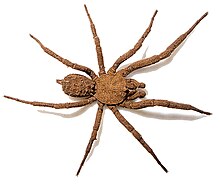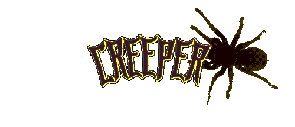Post by Creeper on Apr 9, 2015 22:33:13 GMT 5
Paratropis tuxtlensis

Paratropis tuxtlensis is a species of spider in the family Paratropididae (baldlegged spiders). Discovered in 2014 by a group of researchers from the National Autonomous University of Mexico, the species is only known to occur in the Volcán San Martin Biosphere Reserve in Veracruz, Mexico.
Description
The holotype male measured 8.20 millimeters in length, and the paratype female measured 12.90 millimeters. When cleansed of soil (see Behavior, below) the body is reddish, with orange coloration on its chelicerae, sternum, endites, and labium. Legs are olive colored, and spinnerets are yellow.
P. tuxtlensis is distinguished from Paratropis papilligera, the only other species of Paratropis where the male is known, by its conical as opposed to cylindrical tibia and by the number of teeth in the cheliceral furrows: P. tuxtlensis has a total of 20 while P. papilligera has 24. The species has an orbiculate carapace and legs covered in barbed and clubbed setae.
Distribution & Habitat
P. tuxtlensis is the first member of the family Paratropididae to be found in North America. It is native to tropical rainforest in Veracruz, Mexico. The first recorded specimens were discovered under rocks at an elevation of 1,039 metres (3,409 ft); two more individuals were collected nearby at a lower elevation.
Etymology
The species name P. tuxtlensis is derived from Los Tuxtlas, Veracruz, the only place to date where it has been found.
Behavior
P. tuxtlensis excretes a sticky substance from glandular pores in its exoskeleton, which helps particles of soil adhere to its body. This most likely serves as a form of camouflage to conceal it from both predators and prey. When exposed, the spider remains completely motionless in order to avoid detection.

Entomologists led by Dr Alejandro Valdez-Mondragón have described a new species of spider from a tropical rainforest in Veracruz, Mexico.
The new species, named Paratropis tuxtlensis, belongs to the enigmatic family Paratropididae.
Members of this spider family are well known for their unique camouflaging abilities. Paratropis tuxtlensis is not the exception – its entire body is encrusted with soil particles.
The encrusted soil on the exoskeleton of Paratropis tuxtlensis could provide protection from predators or serve as camouflage to deceive its prey. The soil particles are because the spider has glandular pores in the cuticle and their secretion help to stick the soil particles.
Paratropis tuxtlensis is very cryptic, which coupled with lack of movement when exposed makes it quite difficult to find and collect.
Paratropis tuxtlensis is known only from the region around the type locality in the Volcán San Martin Biosphere Reserve, Mexico.
Typically, the spider doesn’t make burrows but rely on its camouflage to hide under rocks and in the soil.
“The specimens were collected in tropical rain-forest, under boulders on the ground,” said Dr Valdez-Mondragón, the first author of a paper published in the open-access journal ZooKeys.
“They remained motionless when they were exposed by removing the rock that provided shelter, possibly as a defense mechanism because the soil particles encrusted on the body cuticle serves as camouflage with the moist ground.”
www.sci-news.com/biology/science-new-species-spider-strange-camouflage-mexico-02015.html

Paratropis tuxtlensis is a species of spider in the family Paratropididae (baldlegged spiders). Discovered in 2014 by a group of researchers from the National Autonomous University of Mexico, the species is only known to occur in the Volcán San Martin Biosphere Reserve in Veracruz, Mexico.
Description
The holotype male measured 8.20 millimeters in length, and the paratype female measured 12.90 millimeters. When cleansed of soil (see Behavior, below) the body is reddish, with orange coloration on its chelicerae, sternum, endites, and labium. Legs are olive colored, and spinnerets are yellow.
P. tuxtlensis is distinguished from Paratropis papilligera, the only other species of Paratropis where the male is known, by its conical as opposed to cylindrical tibia and by the number of teeth in the cheliceral furrows: P. tuxtlensis has a total of 20 while P. papilligera has 24. The species has an orbiculate carapace and legs covered in barbed and clubbed setae.
Distribution & Habitat
P. tuxtlensis is the first member of the family Paratropididae to be found in North America. It is native to tropical rainforest in Veracruz, Mexico. The first recorded specimens were discovered under rocks at an elevation of 1,039 metres (3,409 ft); two more individuals were collected nearby at a lower elevation.
Etymology
The species name P. tuxtlensis is derived from Los Tuxtlas, Veracruz, the only place to date where it has been found.
Behavior
P. tuxtlensis excretes a sticky substance from glandular pores in its exoskeleton, which helps particles of soil adhere to its body. This most likely serves as a form of camouflage to conceal it from both predators and prey. When exposed, the spider remains completely motionless in order to avoid detection.

Entomologists led by Dr Alejandro Valdez-Mondragón have described a new species of spider from a tropical rainforest in Veracruz, Mexico.
The new species, named Paratropis tuxtlensis, belongs to the enigmatic family Paratropididae.
Members of this spider family are well known for their unique camouflaging abilities. Paratropis tuxtlensis is not the exception – its entire body is encrusted with soil particles.
The encrusted soil on the exoskeleton of Paratropis tuxtlensis could provide protection from predators or serve as camouflage to deceive its prey. The soil particles are because the spider has glandular pores in the cuticle and their secretion help to stick the soil particles.
Paratropis tuxtlensis is very cryptic, which coupled with lack of movement when exposed makes it quite difficult to find and collect.
Paratropis tuxtlensis is known only from the region around the type locality in the Volcán San Martin Biosphere Reserve, Mexico.
Typically, the spider doesn’t make burrows but rely on its camouflage to hide under rocks and in the soil.
“The specimens were collected in tropical rain-forest, under boulders on the ground,” said Dr Valdez-Mondragón, the first author of a paper published in the open-access journal ZooKeys.
“They remained motionless when they were exposed by removing the rock that provided shelter, possibly as a defense mechanism because the soil particles encrusted on the body cuticle serves as camouflage with the moist ground.”
www.sci-news.com/biology/science-new-species-spider-strange-camouflage-mexico-02015.html


